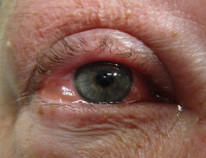Allergic conjunctivitis is a Type 1 (immediate IgE) reaction involving mast cell degranulation. It is characterised by bilateral itchy papillary conjunctivitis.

Overview
There are 4 types of allergic conjunctivitis to learn:
- Perennial and seasonal are common subacute conditions mediated by a type 1 hypersensitivity reaction with mast cell degranulation.
- Vernal Keratoconjunctivitis (VKC) and Atopic Keratoconjunctivitis (AKC) are clinically serious with a chronic/recurrent component mediated by a type 4 hypersensitivity component in addition to the acute type 1 reaction.
Management
Centres around immune modulation and can be thought of as a treatment ladder:
- Artificial tears to dilute allergen and restore surface integrity
- Mast cell stabilizers and/or antihistamines
- Topical steroids
- Systemic immunosuppression with steroids or steroid-sparing agents such as cyclosporine
- Surgical debridement and/or keratectomy to address corneal ulcers in vision-threatening disease
When using immunosuppression, you should be aware of HSV reactivation - patients should receive antiviral therapy.
Seasonal Conjunctivitis
A common subacute conjunctivitis seen in hay fever.
Pathology
- Type 1 hypersensitivity reaction with mast cell degranulation
- Typically triggered by pollen in the summer period
Presentation
- Subacute bilateral itchy conjunctivitis
- Characteristic seasonal pattern of onset and prior episodes
- Often accompanied by allergic rhinitis symptoms
Management
Often benign and self-limiting. Treatment options include:
- Allergen avoidance and cold compresses
- Artificial tears to dilute allergen and restore surface integrity
- Mast cell stabilizers and/or antihistamines
Perennial Conjunctivitis
A similar disease to seasonal conjunctivitis, except it can occur at any point and does not necessarily follow a seasonal pattern.
Pathology
- Type 1 hypersensitivity reaction with mast cell degranulation.
- Caused by allergy to perennial allergens such as dust mites, animal dander, moulds, and certain foods
Presentation
- Subacute bilateral itchy conjunctivitis
- No specific seasonal variation
- Symptoms may worsen in specific environments (home, work)
Management
Often benign and self-limiting. Treatment options include:
- Allergen avoidance and cold compresses
- Artificial tears to dilute allergen and restore surface integrity
- Mast cell stabilizers and/or antihistamines
Vernal Keratoconjunctivitis
A recurrent conjunctivitis that characteristically effects teenage boys
Pathology
- An acute type 1 hypersensitivity reaction with mast cell degranulation followed by a chronic type 4 hypersensitivity mediated by T cells.
- The additional type 4 component makes this disease chronic
- Subtypes are categorised based on which part of the conjunctiva is affected: palpebral, limbal or mixed
Presentation
- Manifests in adolescent boys in dry climates
- Initial onset is often in the summer
- Also involves the cornea
- Effects the upper conjunctiva with characteristic cobblestone appearance
Management
Clinically serious and likely to require steroids during acute attacks and steroid-sparing agents long term to reduce attack frequency
- Artificial tears to dilute allergen and restore surface integrity
- Mast cell stabilizers AND/OR Antihistamines
- Topical steroids
- Systemic immunosuppression with steroids or steroid-sparing agents such as cyclosporine
- Surgical debridement AND/OR keratectomy to address corneal ulcers in vision-threatening disease
Atopic Keratoconjunctivitis
This is the most severe disease of the group and is characteristically associated with other atopic conditions.
Pathology
- An acute type 1 hypersensitivity reaction with mast cell degranulation followed by a chronic/recurrent type 4 hypersensitivity mediated by T cells.
- The additional type 4 component makes this disease chronic
Presentation
- Affects the lower conjunctiva
- More associated with lid diseases such as: blepharitis and eczema
- May have corneal involvement with neovascularization and scarring
Management
Clinically serious and likely to require steroids during acute attacks and steroid-sparing agents long term to reduce attack frequency
- Artificial tears to dilute allergen and restore surface integrity
- Mast cell stabilizers AND/OR Antihistamines
- Topical steroids
- Systemic immunosuppression with steroids or steroid-sparing agents such as cyclosporine
- Surgical debridement AND/OR keratectomy to address corneal ulcers in vision-threatening disease
Calcineurin inhibitors are highly effective in exacerbations of AKC

